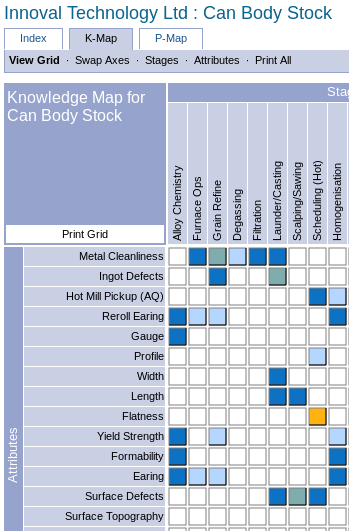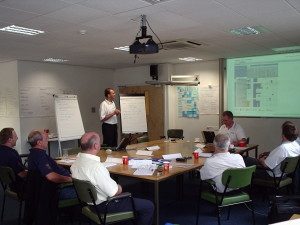Posted on: 11th July 2017 by Private: Steve Walton
We first developed K-Maps back in 2003. Since then technology has moved on, so we’ve completely rewritten our K-Map software. This blog briefly describes what’s changed and how we’ve improved K-Maps from a technology point of view.
What is a K-Map?

In a climate of mergers and acquisitions and the inevitable restructuring this brings, it’s vitally important to safeguard your company’s knowledge. A K-Map (Knowledge Map) is a user friendly tool that enables you to do this.
We developed K-Maps to provide a structured approach to Knowledge Management. The K-Map process enables manufacturing companies to easily capture valuable knowledge. What’s more it’s accessible to the people who need it.
Part of K-Map is a suite of software that runs on your company’s servers. Alternatively, you can host it on a secure extra-net on your company’s behalf. This delivers a web front end onto the knowledge which you view through a browser.
Version 2 of the K-Map software
We developed the original K-Map software suite in 2003. This original version used Flash-based technology which was, at the time, the forefront of web innovation. Since then the computer environment has changed greatly and Flash is not now seen in quite the same light. In fact, tablets and smart phones do not support Flash, and Apple devices have blocked it!
Because of the above, we needed a new version of the K-Map interface. It had to be a version that would conform to modern web standards and modern browsers on a variety of devices.
The best way to meet these objectives was to rewrite the program using html 5 standards and techniques. This then gave us the opportunity to improve the K-Map software in other areas. Consequently, we identified two key areas for development; deployment and backup.
Key improvements
One way to make an improvement in both these areas was to change the database engine. The original K-Map software only worked with a Microsoft Access database. This is not really an ideal database for a web application. Therefore, we’ve written the new K-Map software so that the user can choose from a selection of database engines. These include MySQL, Microsoft SQL server, Oracle, PostgreSQL and MariaDB. However, the default database engine for the new K-Map software is MySQL.

One problem with backups on the original software was that local user content could go into in any local folder. This made the local user content difficult to identify for backup and difficult to restore.
In the new K-Map, we restrict the local user content to a specific folder. This way, once you back up this folder and any sub-folders, all the local user content gets backed up too. Furthermore, it’s possible to use remote content in the K-Map, but this doesn’t play a part in the backup process.
Deployment
Deployment is another area that has changed greatly in recent years. We developed the original K-Map to be deployed on a Microsoft Intranet Information Server (IIS) inside a company’s Intranet. This was a perfectly reasonable way to deploy a web application, but it did lack flexibility. If your company’s web server is not IIS then it is a significant overhead to use IIS in addition to the company standard web server.
A big breakthrough in this area is the use of containers to isolate software packages and standardise installation and maintenance. Alongside the Cloud, the idea of software as a service means that there are many more deployment options for software packages. The new K-Map software is able to leverage these changes by using Docker.
Docker is one of the leading container standards and is widely supported. We supply the new K-Map software as a Docker image. This means the user can deploy the software locally on their own server but without the problems of having to buy, learn and support a potentially new web server software. Alternatively, the user can purchase Docker space on the internet and deploy the K-Map software from there. As a third deployment option, Innoval can provide Docker space to host the K-Map on behalf of our clients.
What’s next?
These upgrades to the K-Map software are evolutionary changes which bring the software up to date with the modern internet. Furthermore, these updates mean the user can view K-Maps on his/her tablet and smart phone. Future developments might radically modify the interface to adapt to the smaller screens on smart phones and take advantage of the multi touch user interface.
Finally, if you’d like to know more about our approach to Knowledge Management, or you have questions relating to the software we’ve developed, please get in touch.



